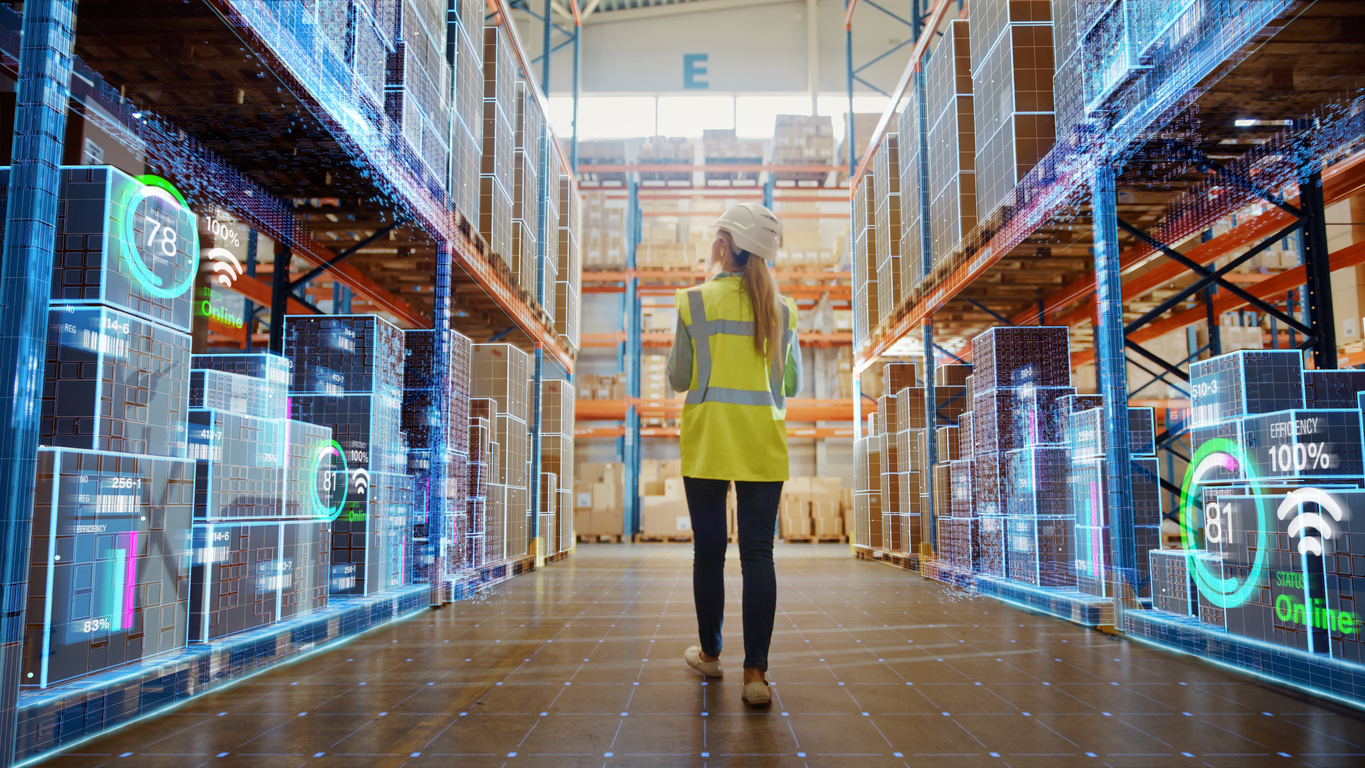Tech Innovation, Diversifying Sources Drive the Supply Chain Game
Despite the AI hype, it’s physical assets and services that industrials businesses—and dealmakers—are turning to for more resilient supply chains

The industrials sector comprises a variety of verticals, but what they all have in common are intricate, risk-heavy supply chains.
Whether pharmaceuticals, energy or aerospace, industrial businesses manage the sourcing of materials from a wide net of suppliers, transportation and warehousing of bespoke components, management of heavy machinery, manufacturing of complex and often large products, and the logistics of moving materials and products along the chain—with risks at every turn.
In a report released last November, business consulting firm Aon found supply chain-related issues to be top concerns for industrial and manufacturing companies. Its Global Risk Management Survey revealed sourcing issues to be the No. 1 risk facing respondents, while supply chain or distribution failure landed at No. 2, up from fourth place the year prior.
Organizations learned some tough lessons during the pandemic-era supply chain crisis. With artificial intelligence and data analytics now a key focus for businesses and M&A dealmakers alike, companies in the industrial supply chain are closely watching how new technologies can improve the way they do business. But it’s physical assets and solutions—from warehouses to machinery—that are driving M&A in this space.
Evolving Factory Floors
Post-pandemic, industrial organizations continue to struggle with supply chain inefficiencies and bottlenecks.
James Tannahill, president of Plocamium Holdings, a private equity services firm that launched earlier this year, says industrial companies with shorter product life cycles have been hit especially hard. For an aerospace business fulfilling an order for a defense system, the life cycle from customer contract negotiations through fulfillment can take years, allowing for greater leeway should supply chain issues arise. Yet for companies that manufacture biopharmaceuticals or chips, he notes, shorter product life cycles demand quick pivots.
That need for agility is why Tannahill says automation technology in manufacturing and inventory management will be key to the industrial supply chain moving forward. “Things have changed in the last 20 or 30 years,” he says. “Factory floors look different. You have to adopt technology to be successful in the industrial space.”
Things have changed in the last 20 or 30 years. Factory floors look different. You have to adopt technology to be successful in the industrial space.
James Tannahill
Plocamium Holdings
For many businesses and investors, data-centered solutions wielding advanced analytics capabilities and even artificial intelligence are expected to drive modernization in the factory and beyond. Real-time visibility remains key to agility, and experts agree that data has grown exponentially more important for industrial businesses in need of actionable insights.
That could mean accessing information about the status of a good in the process of being manufactured, inventory levels of raw materials, machinery maintenance and repair requirements, supplier pricing changes and even weather patterns that could impact the shipment of goods across borders.
“We’ve seen more adoption of supply chain analytics, really out of necessity when you look at all the chaos around the supply chain, particularly in ’21 and ’22,” says Gordon Mackay, managing director, logistics and supply chain, at investment bank and advisory firm Capstone Partners.
AI on the Rise—But Buyer Beware
Mackay highlights the potential of AI to have a particularly large impact on predictive supply chain analytics solutions that can not only enhance real-time visibility into key processes and risks but forecast factors that are likely to affect those processes.
“The companies that will benefit most (from this technology) are those with complex global supply chains, where they need to be sourcing various inputs and goods and commodities from around the world,” says Mackay. He adds that AI will have the greatest impact in sourcing, fulfillment and risk management, thanks to its ability to pull together vast quantities of unstructured data.
Mackay points to niches including high-value goods like semiconductor equipment, pharmaceuticals and others that rely on valuable equipment to manufacture, store and transport products as areas that will benefit from AI, automation and other supply chain technologies, while also seeing the greatest investment in these tools. “The amount of investment in and focus on the space is high and as strong as it’s ever been,” he says.
But investors in AI solutions must be vigilant, he warns.
“If you talk to supply chain managers of manufacturers or logistics companies, what they will tell you is, ‘yes, we’ve invested a lot (in AI), but it doesn’t necessarily mean we’ve achieved what we wanted to achieve,’” notes Mackay.
With so much hype around AI, it’s unsurprising that a flood of solutions is saturating the market, with some products performing more effectively than others. “It’s a problem for many investors,” notes Tannahill. “AI is a buzzword. It’s easy to get excited.” But, he continues, there are investors who get excited without first seeing a working product.
Savvy acquirers, both strategic and private equity, should consider whether a product meets regulatory requirements and can be modified to fit shifting needs and regulations. “That’s what separates the good investors from the investors that have a huge, long learning curve ahead of them,” Tannahill adds. “There is not a one-size-fits-all AI solution, and if you come across one, you’d better run.”
Physical Solutions Drive Dealmaking
AI will undoubtedly continue to intrigue industrial companies and sponsors as we round out 2024 and head into 2025. When it comes to M&A, organizations have focused on acquisitions of physical assets and solutions—not SaaS—that support geographic and supplier diversification.
“There is more of a desire to shore up assets and relationships with different logistics and warehouse service providers, fulfillment centers, etc., across the country and ensure supplier diversification,” says Alison LeVasseur, a partner at law firm Alston & Bird, who adds that strategic and sponsored acquisitions can allow an organization to broaden its resource base.
Alston & Bird recently advised packaging distributor and print solutions provider Veritiv Corp. on its acquisition of Ameripac, a contract packaging and fulfillment services solution provider. In addition to augmenting Veritiv’s offerings, the transaction expanded the company’s footprint within Texas and Pennsylvania, supporting its efforts “to create a national platform,” Veritiv CEO Sal Abbate said in a statement when the deal was announced.
In another packaging deal this year, Wynnchurch Capital-backed FCA Packaging acquired Greentree Packaging and Lumber, a custom wood packaging manufacturer.
Warehousing M&A has also risen as a result of growing demand for geographic diversification. A recent report by law firm White & Case highlighted increased deal activity in self-storage facilities, for example, which “became a lifeline for private businesses looking to store surplus stock and inventory” amid ongoing supply chain disruptions. The space saw two major deals last year: the $12 billion merger between Life Storage and Extra Space Storage, and the $2.2 billion acquisition of Simply Storage by Public Storage. Meanwhile, last year private equity real estate firm Prime Group Holdings raised $2.5 billion for its Prime Storage Fund III, which will focus exclusively on self-storage investments.
Down the Line
AI may not be driving M&A volume yet, but investors continue to focus on technology-enabled solutions in their investment strategies.
In warehousing, for instance, B2B software-focused private equity firm Nexa Equity announced a $31 million investment in warehouse and manufacturing labor analytics company Easy Metrics in May. And in April, One Equity Partners announced its acquisition of Ballymore Safety Products, a distributor and manufacturer of safety products that facilitate the movement of people and goods throughout warehouses and factories. “Companies are increasingly looking for innovative technologies and solutions that ensure worker safety and enhance productivity,” OEP partner Steve Lunau said in the announcement.
This year also saw a $33 million fundraise secured by GoExpedi, a procurement and supply chain management platform developed for heavy industry. Investors included hedge fund titan Tiger Global, and private equity firms Cortes Capital and Labyrinth Capital Partners, among others.
As AI-powered solutions mature, investors will continue to prioritize technology-forward services and products in their deal pipelines. Tannahill says middle- and lower middle-market companies will drive M&A volume, particularly across borders. “I do think there will be strategic acquirers, both domestic and foreign,” he says. “Frankly, some of the more interesting activity is going to come from foreign strategics, especially in the Gulf states.”
Further, LeVasseur says an acceptance of the “new normal” of interest rates will likely spur M&A activity, adding that she doesn’t anticipate the upcoming presidential election to have much of an effect on the sector.
What will impact the success of dealmaking, however, can be found at the negotiation table. “Offering some rollover equity as a means of getting the deal done and bridging valuation gaps, incentivizing people to retain talent, investing in really good management teams” will all help get deals across the finish line, says LeVasseur. “I do see a lot of opportunity, especially in the lower middle market,” she adds. “There’s a lot of optimism.”
Carolyn Vallejo is ACG’s Digital Editor.
Middle Market Growth is produced by the Association for Corporate Growth. To learn more about the organization and how to become a member, visit www.acg.org.


